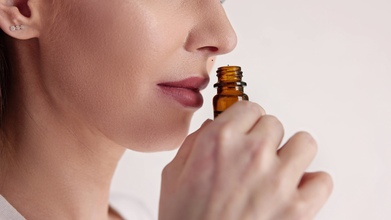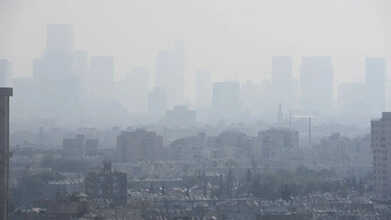- Health Conditions A-Z
- Health & Wellness
- Nutrition
- Fitness
- Health News
- Ayurveda
- Videos
- Medicine A-Z
- Parenting
- Web Stories
Your Sense Of Smell Could Decide How Long You Live, According To Doctor

Credits: Canva
Smell is a sense that helps us navigate, feel, and in fact remember things. Thanks or not, but Covid-19 also helped us know its importance, when many people lost the sense of their smell, as one of the major COVID-19 symptom. But, that is not just it, in a podcast posted on Instagram Dr Sanjay Bhojraj, board-certified interventional cardiologist talked to Dr Michael Leon, PhD Professor Emeritus of Neurobiology and Behavior at the Charlie Dunlop School of Biological Sciences on surprising link between smell and overall well-being.
Can Smell Predict How Long Will You Live?
“By the time you reach middle age, your sense of smell can actually predict all-cause mortality,” says Dr Leon. “That means whether you live or die, for any reason, can be accurately reflected in your ability to detect odors.”
The expert says that out olfactory system bears a direct impact to the brain's memory and emotional centers. “It has a great deal of impact when you lose it. And also when you amplify it. When you smell a pleasant odor, it activates the cerebellum and increases sniffing. For example, when you smell a rose, you naturally take a deep sniff.”
How Does Smell Impact Your Brain?
When you encounter a bad or disgusting odor, your body reflexively stops respiration. You instinctively avoid breathing it in,” Dr Leon says.
The expert said it is these subtle responses that influence one's memories, emotions, and overall brain function. “The olfactory system is just much more powerful than most people realize,” he says.
Can Body Odor Also Reveal Things About Your Health?
This link between smell and health became famous when Joy Milne, a retired Scottish nurse, claimed she could detect Parkinson’s disease by scent alone. Years before her husband’s diagnosis, she noticed a distinct musky odor on him. When she later met others with Parkinson’s, they all carried the same smell. Curious scientists put her to the test — and she correctly identified patients just by sniffing their shirts, even predicting one man’s diagnosis a year before doctors confirmed it.
Her unique ability led researchers like Professor Perdita Barran at the University of Manchester to discover that people with Parkinson’s excrete specific lipid-like molecules through their skin. These include hippuric acid and octadecanal, which may form the disease’s distinct odor. Barran’s team is now developing a simple skin-swab test that could help doctors detect Parkinson’s much earlier.
Different diseases create different odors. For example, a fruity or “rotten apple” smell can indicate uncontrolled diabetes, caused by a build-up of ketones. A fishy or ammonia-like scent might suggest kidney problems, while a musty smell could point to liver disease. Even infections leave olfactory traces — cholera, tuberculosis, and C. difficile each produce distinct, unpleasant aromas.
Severe AQI In Delhi: Why Early Morning Walks Can Be Dangerous For Senior Citizens

Credits: Canva
Thick smog blanketed India’s capital on Tuesday (October 21), a day after millions celebrated the Hindu festival of Diwali with fireworks that pushed air pollution to dangerous levels across the city. People in New Delhi kept bursting firecrackers late into Monday night, filling the air with smoke and fine particles. These mixed with the usual seasonal pollution and still weather conditions, creating a hazardous atmosphere.
By Tuesday morning, the city’s Air Quality Index had crossed 350 in several neighborhoods, classified as “severe” and unsafe to breathe according to the World Health Organization’s recommended daily exposure limits. With pollution levels this high, is it truly safe for senior citizens, or anyone, to go for their usual morning walks?
Delhi Air Quality Reaches ‘Severe Category’
Air pollution occurs when harmful substances like particulate matter (PM2.5 and PM10), carbon monoxide, nitrogen oxides, and other toxic gases contaminate the air, affecting both health and the environment. After Diwali, pollution often spikes due to widespread firecracker use, which releases large amounts of smoke and fine toxic particles. Cooler temperatures and low wind during this season trap these pollutants near the ground, forming thick smog. This makes outdoor activities, such as walking, risky, especially for those with respiratory issues, allergies, or heart conditions.
Data shows that the average AQI hit 451 early on October 21, 1.8 times above the national average as pollution soared after the festive celebrations. Later, the city’s AQI improved slightly to 352 by 9 am, falling into the ‘very poor’ category, according to the Central Pollution Control Bureau (CPCB). Several areas were still in the red zone, with readings like Wazirpur (435), Dwarka (422), Ashok Vihar (445), and Anand Vihar (440), all recording ‘severe’ pollution levels.
Should You Go For Morning Walks After Diwali Week Amid High Air Pollution?
Health experts strongly advise against going for morning walks in the week following Diwali, as air pollution tends to peak during this period. Staying indoors is the safest option to protect your health from toxic particles. Instead, exercise inside your home, postpone outdoor walks until air quality improves, and wear an N95 mask if you must step out for short periods.
Morning walks in heavily polluted air are particularly risky, as cooler temperatures and low wind trap pollutants near the ground. Walking in such conditions increases inhalation of PM2.5 and PM10, as well as harmful gases, which can irritate the lungs, worsen asthma, trigger shortness of breath, and raise the risk of long-term heart and lung problems. Children, older adults, and anyone with pre-existing health conditions are especially vulnerable.
Tips To Stay Safe After Inhaling ‘Severe’ Air Pollution
Living in severe air pollution can make you feel breathless or create a heavy sensation in your chest. You may also experience persistent allergies such as colds, constant sneezing, or coughing. Air pollution can even affect mental health, weaken immunity, and make you more prone to fever. To protect yourself:
Check which areas have better air quality, whether indoors or outdoors. Use an AQI app or monitor for outdoor levels, and an indoor air quality monitor for home safety. Your lungs need breaks from constant exposure to dust and pollutants.
Drink plenty of fluids: Staying hydrated is crucial after breathing polluted air. You can also sip natural teas like green tea, turmeric, or ginger water, which are rich in antioxidants. Research from the NIH suggests water can help reduce inflammation caused by pollution.
Keep yourself clean and comfortable: Fine dust clings to your clothes and hair, prolonging exposure. Take a shower as soon as possible, change into fresh clothes, and try breathing exercises. You can also use a saline spray to cleanse your nasal passages.
Monitor your symptoms: Rest and watch for heaviness in the chest, continuous coughing, runny nose, headaches, chest pain, or difficulty breathing. These could signal health effects from pollution exposure.
Don’t ignore warning signs: If you notice any of the above symptoms, consult a doctor immediately. Early attention can prevent serious health complications. Explain your symptoms fully to receive appropriate treatment.
90% American Adults Are At Risk For This Condition, But Most Do Not Know Of It, New AHA Survey Reveals

(Credit-Canva)
Diseases do not always have linear symptoms. For example, if you have heart problems, then the symptoms may not always be chest pain; it could also show up in different ways. This shows how interconnected our organs are, one organ lacking, could burden the other causing problems. Similarly, did you know there is a disease that affects not just your heart, but also your kidney and digestive health? This disease is much more common than you think, however, a new survey showed that most people do not know about it.
A recent survey by the American Heart Association (AHA) found a huge gap in health knowledge: a staggering 9 out of 10 American adults have never heard of Cardiovascular-Kidney-Metabolic (CKM) syndrome. This lack of awareness is a major problem because the condition is so widespread; it affects or puts at risk nearly 90% of all adults.
CKM syndrome is a relatively new term used to describe the coexistence of several serious health problems at the same time: heart disease, kidney disease, diabetes, and obesity. The AHA defined it to make people realize that these conditions don't happen in isolation; they are deeply connected. Even though few people know the name CKM syndrome, the survey did find an upside: most people who learned about it were very interested in getting more information.
What is CKM and Who Is At Risk?
CKM syndrome is all about the dangerous link between three essential body parts: the heart (cardiovascular system), the kidneys, and the metabolic system. The metabolic system is like your body energy factory; it handles how you create, use, and store energy, which directly influences your weight and blood sugar levels. When one of these systems starts to fail, it often puts extra strain on the others, creating a vicious cycle that quickly makes all the conditions worse.
A 2024 study published in JAMA found that the following are common risk factors for CKM syndrome, and nearly 90% of Americans have at least one:
- High blood pressure
- Abnormal cholesterol
- High blood sugar
- Excess weight
- Reduced kidney function
The key message is that having several of these risk factors together is much more dangerous than having just one. It greatly increases your chances of having a life-threatening event like a heart attack or stroke. The good news is that CKM syndrome isn't set in stone; for most people, it can be reversed or significantly improved by changing what they eat, increasing physical activity, and getting the right medical care.
Do People Know What Cardiovascular-Kidney-Metabolic Syndrome Is?
The AHA survey, which collected responses from about 4,000 U.S. adults in 2025, made it clear that a public education effort is urgently needed. The main results showed low awareness but high interest:
- 12% had heard about CKM syndrome
- 72% were interested in learning more
- 79% though it was important to understand CKM
The survey also uncovered some dangerous misconceptions about managing health:
- 68% of adults incorrectly believe that the best way to handle heart, kidney, and metabolic conditions is to treat them one at a time, or they simply don't know the best approach.
- 42% of adults either doubt or are unsure that a healthy heart could actually be damaged by problems in other organ systems.
AHA Chief Medical Officer Dr. Eduardo Sanchez stressed that since these body systems are so interconnected, they must be treated in a coordinated way by healthcare providers.
How Can We Prevent CKM Syndrome?
The American Heart Association (AHA) knows that almost no one has heard of CKM syndrome, so they are starting a major effort called the CKM Health Initiative.
The main goal is simple, to teach the public how the heart, kidneys, and metabolism are all connected. By showing people these links, the AHA hopes to encourage everyone to act early to prevent major health issues like heart attacks and heart failure.
Teaching the Public
The AHA is making easy-to-read materials and launching a website to clearly explain the connections. They are stressing that everyone needs to get regular check-ups for important health numbers like blood pressure, cholesterol, weight, blood sugar, and kidney function.
Training Doctors
The AHA is working directly with doctors and healthcare teams across the country. The goal is to get doctors who treat different conditions to work together better so they can provide coordinated care for patients who have multiple health problems.
In addition to this, the AHA is taking a major leadership step. They are preparing to release the first-ever official clinical guidelines for CKM syndrome in early 2026. These guidelines will give doctors a clear, tested set of rules for how to best diagnose and treat the condition.
Is It Possible To Get The Same Cold Twice?

Credits: Canva
Did you also wake up with a mild cold? A sneeze, blocked nose and a sore throat. It is worse because you had just shaken off the miserable cold and your energy was finally coming back and then now again you are sneezing. So, now the question is, could you really get the same cold twice, or is it just your bad luck?
As per the National Health Service, UK (NHS), adults could get an average of 2 to 4 colds a year. The NHS, UK notes that the viruses behind them behave in a complicated way. This is because some mutate quickly, and some stay in your system. This is why your body's ability to fight them off can differ depending on how well does your immune respond.

Catching The Same Cold, Twice
Conventionally, it is believed that once you have a virus, your body recognizes it and does not let you catch the same virus again. However, this is not the case, always.
Professor Brain Ferguson, who is the professor of viral immunity at the University of Cambridge told Yahoo UK, that it is possible to catch cold twice. This is due to the levels of antibodies that we have in our system.
Ferguson says, "It depends on the quality of the antibodies that your body generates when you get infected the first time. Sometimes your body might make really good ones, and that will stop you being reinfected with the same virus later. But another person might not, and they can catch the same virus, exactly the same one, again later."
The expert further added, "It is also down to the actual molecules, and the constituents of the virus, like proteins and things you make antibodies against. The longer they exist in your body, the better the antibody response tends to be."
This means that the cold can stay in your system, and the longer it stays the better your immune system will be prepared to build up a stronger defense.
Reinfection Time: How Long Does It Take?
If you had two colds very close together, you may not have had enough time to build immune response the first time. Ferguson says, "Reinfection can be very fast."
"It can be as soon as a couple of weeks if the antibody response is very weak... You might pick up a virus and get a few minor symptoms, but fight it off really quickly. In that case, you get much weaker antibodies that fight the virus, which means the same virus appears in your system again very quickly."
This means your body only has a "fleeting encounter" with the virus and thus it won't remember it well enough to protect you the next time. However, a more severe cold may trigger a stronger immune response, which can work as a longer-lasting protection.
Why Some People Catch More Often?
This has something to do with genetics. This is because of their immune system, how good it works against different infections. As Ferguson says, "Some people are just naturally better or worse at fighting off viruses or bacteria due to their genetic makeup."
While it is believed that multivitamins and supplements can help "boost" immunity, Ferguson says that the evidence is mixed.
There’s not a great evidence base for [vitamins] for repeat infections," he says. However, Ferguson adds there is evidence that people who spend more time outside and get more vitamin D tend to have a slightly better-functioning immune system.
© 2024 Bennett, Coleman & Company Limited

